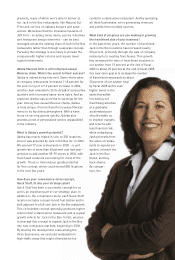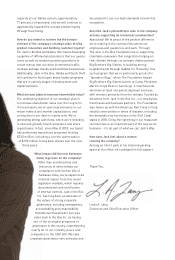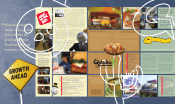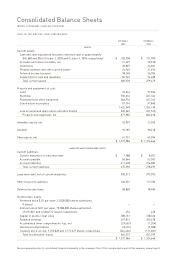Jack In The Box 2005 Annual Report Download - page 18
Download and view the complete annual report
Please find page 18 of the 2005 Jack In The Box annual report below. You can navigate through the pages in the report by either clicking on the pages listed below, or by using the keyword search tool below to find specific information within the annual report.
PART I
ITEM 1. BUSINESS
The Company
Overview. Jack in the Box Inc. (the “Company”) owns, operates and franchises JACK IN THE BOX® quick-service
hamburger restaurants and Qdoba Mexican Grill® (“Qdoba”) fast-casual restaurants. In fiscal 2005, we generated total revenues
of $2.5 billion. As of the end of our fiscal year on October 2, 2005, the JACK IN THE BOX system included 2,049 restaurants, of
which 1,534 were company-operated and 515 were franchise-operated. JACK IN THE BOX restaurants are located primarily in the
western and southern United States. Based on the number of units, JACK IN THE BOX is the second or third largest quick-service
hamburger chain in most of its major markets. As of October 2, 2005, the Qdoba Mexican Grill system included 250 fast-casual
restaurants in 37 states, of which 57 were company-operated and 193 were franchise-operated.
Background. The first JACK IN THE BOX restaurant, which offered only drive-thru service, opened in 1951. By 1968,
the JACK IN THE BOX chain had expanded its operations to approximately 300 restaurants. After the Company was purchased in
1968 by Ralston Purina Company, a major expansion program was initiated in an effort to penetrate the eastern and midwestern
markets, and by 1979 business had grown to over 1,000 units. In 1979, the Company decided to divest 232 restaurants in the east
and midwest to concentrate its efforts and resources in the western and southwestern markets, which were believed to offer the
greatest growth and profit potential at that time. In 1985, a group of private investors acquired the Company and, in 1987, a
public offering of common stock was completed. In 1988, the outstanding publicly-held shares were acquired by private
investors through a tender offer. In 1992, a recapitalization was completed that included a public offering of common stock and
indebtedness. Since that time, we have continued to grow, primarily through the addition of new company-operated restaurants,
and we entered new markets in the Southeast beginning in 1999. In addition, to supplement our core growth and balance the risk
associated with growing solely in the highly competitive hamburger segment of the quick-service restaurant (“QSR”) industry, on
January 21, 2003, we acquired Qdoba Restaurant Corporation, operator and franchisor of Qdoba Mexican Grill, expanding our
growth opportunities into the fast-casual restaurant segment.
Strategic Plan. Our goal is to become a national restaurant company by focusing on three key strategic initiatives:
profitably growing the business, reinventing the JACK IN THE BOX brand, and driving product innovation and building customer
loyalty for all of our brands. Our multifaceted growth strategy includes growing our restaurant base, increasing our franchising
activities, continuing to grow Qdoba and expanding our proprietary QUICK STUFF® convenience store concept. Reinvention of the
JACK IN THE BOX brand encompasses upgrades to our menu, guest service and restaurant facilities. Our third strategic initiative
focuses on developing a pipeline of relevant and differentiated products and continuing to build customer loyalty.
Strategic Plan - Growth Strategy. Our growth strategy is multifaceted and includes the following components: (i)
developing new company-operated restaurants, growing sales at existing restaurants and expanding our unique convenience store
concept, QUICK STUFF, a full-service convenience store on a site shared with a full-sized JACK IN THE BOX restaurant and a
branded fuel station; (ii) expanding our franchising activities, and (iii) growing Qdoba, our fast-casual subsidiary.
(i) Company Restaurant Growth. We opened 38 new JACK IN THE BOX company-operated restaurants in fiscal 2005, including
15 restaurants on a shared site with a QUICK STUFF store and fuel station, and 12 new Qdoba company-operated restaurants.
We believe our convenience store concept provides a strong unit economic model and allows for increased penetration of
existing and new contiguous markets by providing additional site development flexibility in unique locations where
development costs are shared among the restaurant, convenience store and fuel station. Fiscal year 2005 restaurant growth
was in existing markets, as we continue to see opportunities to increase our market penetration, and intend to leverage
media, supervision, and food delivery costs. Our fiscal year 2006 growth strategy includes entering new contiguous markets
which we will be able to support with our existing operations and distribution infrastructure.
(ii) Franchise Restaurant Growth. To improve margins and returns on capital over time, our business model includes increasing
the use of franchising as we grow the Company. We will continue expanding franchising activities, including the selective
sale of certain JACK IN THE BOX company-operated restaurants to franchisees. In fiscal 2005, we sold 58 JACK IN THE BOX
restaurants to franchisees and franchisees developed 11 new JACK IN THE BOX and 65 new Qdoba restaurants. Through
continued sales and the development of new franchised restaurants, we intend to increase the percentage of franchised
restaurants in the system to approximately 35% in fiscal 2008 with additional growth in franchising beyond 35% after fiscal
2008.
(iii) Expansion of Qdoba. We will continue to actively grow our fast-casual subsidiary through aggressive franchise growth.
With a substantial number of new stores in its development pipeline and, in 2005, an 11.8% increase in sales at company-
operated restaurants open more than one year (“same-store sales”), Qdoba is well on its way to becoming a national brand
and a leader in the fastest-growing segment of the restaurant industry.
3
























